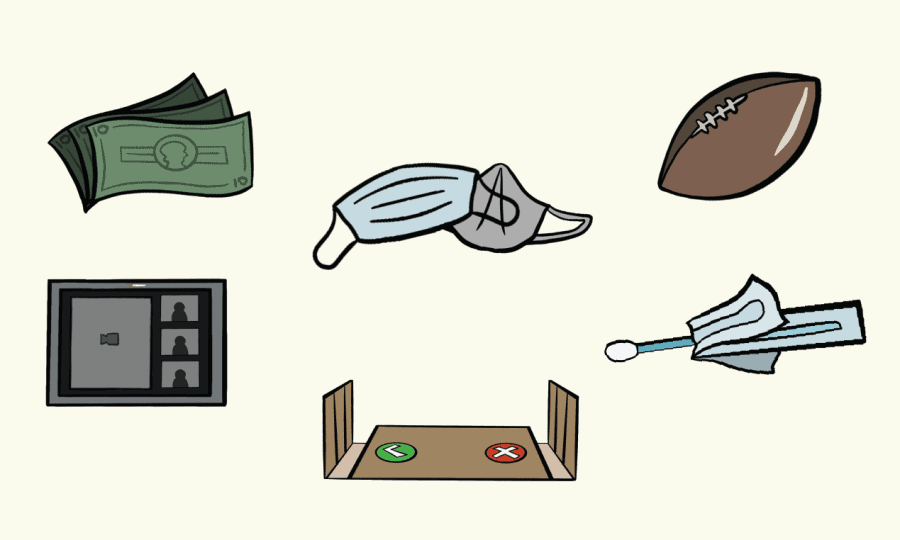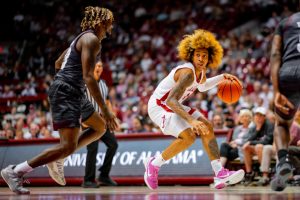How COVID-19 will leave a lingering impact on UA
As the University approaches a fourth COVID-19-affected semester, this is what we know about rules and regulations moving forward.
April 14, 2021
A transition to remote learning after last year’s spring break marked the beginning of more than a year of lasting impact. Now, as the statewide mask mandate has been lifted and vaccines become available for students, faculty and staff, the University is adapting its safety policies.
As the spring semester comes to an end and students look forward to the fall semester, which of these guidelines will remain?
Testing
Before returning to classes in Fall 2020, all students were required to submit a negative COVID-19 test result. This same requirement was limited to on-campus students for the spring semester.
There are no plans to require a negative test result for the upcoming summer or fall semesters.
Sentinel Testing
The sentinel testing program was launched last fall. The campus population is randomly sampled to help UA health officials understand the spread of the virus on campus. Participation was optional for most, and the program fell short of its testing goal. The University offered incentives like Bama Cash and Starbucks gift cards and successfully increased participation in the spring.
Classes
The University extended spring break last year and transitioned to remote learning. Beginning in the Fall 2020 semester, the University adopted a hybrid class model. After a national championship celebration on the Strip with thousands of fans, professors were allowed to suspend in-person instruction for two weeks.
On March 1, the UA System announced its plan for campuses to return to traditional in-person instruction without restrictions on classroom capacity for the Fall 2021 semester.
Masks
The state-wide mask mandate was lifted on April 9. Now, it’s up to individuals and businesses to determine their own mask policies.
The University will continue to require masks inside through the summer semester, but there are no plans in place yet for the fall.
“Beginning May 10, distancing requirements will change from six feet to three feet.” Associate Vice President for Communications Monica Watts said. “Details of specific plans for fall semester will be shared as available.”
Dining Halls
Last year, Lakeside Dining Hall remained open to any students on campus after spring break, but they were not permitted to eat inside. Other dining halls like Burke and Fresh Foods opened back up in the fall with limited dine-in options. The Ferguson Student Center kept its dining areas open but with limitations on the number of people allowed to sit at a table.
Dining halls will remain open in Fall 2021 under updated regulations, including mandatory six feet of distance between tables, a limit of eight people per table and 50% seating capacity. The Transact Mobile Ordering app will still be available for to-go orders.
Sporting Events
All sporting events for the spring 2020 semester, including A-Day, were canceled due to COVID-19. This meant that any postseason events from the previous fall or current spring sports were canceled and not rescheduled. Senior and graduate student-athletes were given the option to either use or forgo their last year of eligibility in the 2021-22 season.
Last fall, students had to opt-in for tickets to all UA sports. Home football games were limited to 20% capacity, and fans had to wear masks and sit in assigned seating to maintain social distancing.
In fall 2021, Bryant-Denny Stadium will return to full capacity, but there is no information yet regarding other fall sports.
Finances
UA’s Division of Finances and Operations created a plan to stay financially stable through the pandemic. The University was able to identify $30 million in budget reductions to balance the overall budget for the fiscal year 2021.
The University received $20.8 million in funding in May 2020 from the CARES Act — half of which was designated to offset institutional expenses. The funds were used to cover personal protective equipment, remote instruction technology, medical personnel costs, COVID-19 Support Programs, and testing and medical supplies.
The University received a total of $31 million for the Higher Education Emergency Relief Fund II in March, which is authorized by the Coronavirus Response and Relief Supplemental Appropriations Act, 2021. About $10 million will be offered to UA students with demonstrated financial need.
The remaining $21 million will be used for COVID-related expenses, scholarships, and lost revenues. Cost and lost revenues will be evaluated over the next few months.
The UA System Health and Task Force will continue to monitor the situation and continue to make any changes necessary in the approach to the Fall 2021 semester.





















